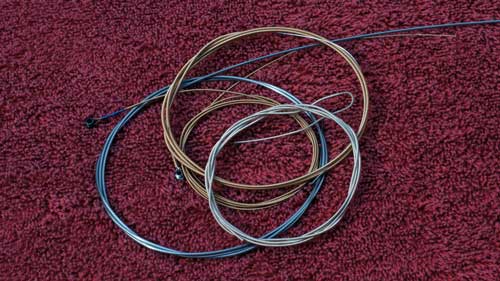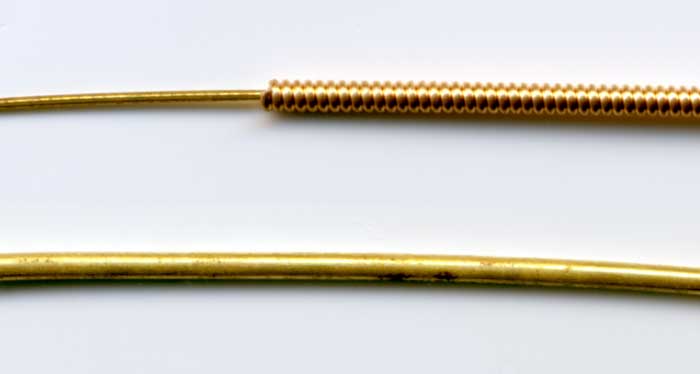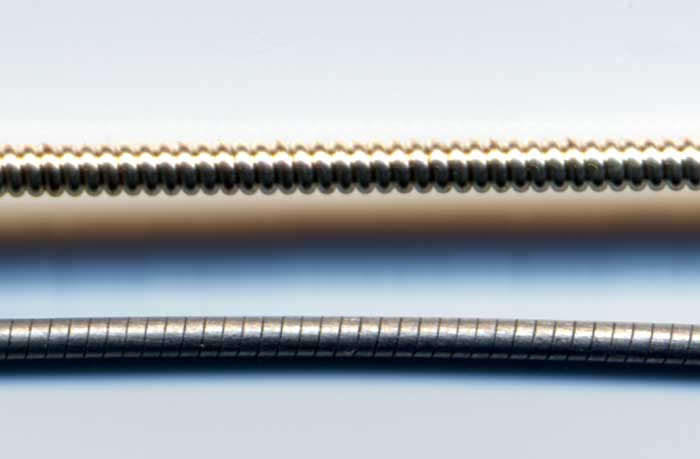Tuning and Stringing the Dilruba or Esraj

| STRINGING AND TUNING THE DILRUBA AND ESRAJ Section 1 – Introduction Section 2 – Basic Concepts of Tuning Section 3 – Overview of Strings Section 4 – Dilruba/Esraj Strings Section 5 – Tools Section 6 – Stringing the Base Section 7 – Stringing the Tuning Pegs Section 8 – Tightening the Strings |
It is very important to select the right strings for your dilruba and esraj. This article will give you a basic overview of strings..
The choice of strings is inextricably linked to the philosophy of tuning. In an ideal situation, you have formulated your approach, and then carefully strung your instrument to reflect this approach. But we are not living in an ideal world. Frequently, someone will just hand you an instrument and ask you to tune it. At that point, you simply have to go with whatever strings the shopkeeper decided to put on it. In which case, you alter your philosophy to reflect the realities imposed by the strings. Therefore, I cannot really tell you which should be approached first, the philosophy, or the actual stringing of the instrument.
In practice, you will find that it probably does not matter. Your approach and strings, will evolve hand-in-hand. You will probably just start with whatever strings were on the instrument when you purchased it. Over time, you will shift strings up or down in gauge and experiment with different tunings. After considerable experimentation, you will find what works for you.
| THESE BOOKS MAY NOT BE FOR YOU |
|---|
A superficial exposure to music is acceptable to most people; but there is an elite for whom this is not enough. If you have attained certain social and intellectual level, Elementary North Indian Vocal (Vol 1-2) may be for you. This has compositions, theory, history, and other topics. All exercises and compositions have audio material which may be streamed over the internet for free. It is available in a variety of formats to accommodate every budget. Are you really ready to step up to the next level? Check your local Amazon. |
Overview of Musical Strings
You will have to make a number of fundamental decisions concerning the stringing of your instrument. Such decisions require a fair amount of basic knowledge concerning strings, materials, and gauges. Such details can become very complicated very quickly. However, we will not go into the arcane aspects of physics, metallurgy, and related areas here. We will just cover information that is important for the dilruba or esraj player to know. This will revolve around the topics of string tension, materials, gauge, and structure of the string.
Tension is probably the single most important factor in determining the pitch of the string. In theory, any string can be tuned to any pitch simply by controlling the tension. In practice, this is definitely not the case. Each string has a “sweet spot” where the tension is just right to allow the string to really express itself. If the tension is too great, the string may break. If the tension is too low, the sound will be weak and muddy. The goal of tuning and stringing any stringed instrument is to have all of the strings working inside their “sweet spot”.
The material that the string is made is important. Today the most common materials to be found on a dilruba or esraj are steel, brass, and bronze. As a general rule, steel has a higher pitch while brass and bronze have lower pitches. Steel is more generic and is more appropriate for most strings; it is the only material that is appropriate for the smaller, main playing string. Bronze tends to be found only on the heavier strings. Brass may also be found on the heavier gauge strings instead of bronze, however this is much less common.
Today, it is common to have strings made of a combination of different materials. In the last hundred years, strings which have one material at the core, but are wrapped with other materials have become very common. These may be steel, but they may also include more exotic materials such as aluminium, titanium, tungsten, or a host of other materials too numerous to describe. (I know you may not consider aluminium an exotic material, but remember, there was not a commercially viable process for refining aluminium until the 19th century.)
Gauge is an extremely important decision. The gauge describes the thickness of the string. As a general rule, the larger gauge strings will be used for the lower pitches, while the finer gauges strings will be used for the higher pitched strings.
The structure of the string is also very important. It may be solid, or it may be wound. If wound, there may be any number of materials or geometry used for the various components. The inner core may be polyfilament; the core may be solid; there may be an intermediate layer of silk threads. It is almost impossible to try keep up with the complexities of string technology. However, we will look at the common structures more closely.

In the above illustration we see an example of two different structures of strings. The upper illustration is a wound string while the lower example is a more traditional solid string.
We can easily grasp the reason for having wound strings. Just think of a guitar or any other instrument with a metal strings and imagine the sound when you strike it. Now imagine a xylophone, glockenspiel, or any similar instrument made with steel bars. It is easy to imagine how a string vibrates in a totally different fashion from a metallic bar.
As strings become thicker, the distinction between a vibrating bar and a vibrating string starts to blur. It tends to behave more and more like a vibrating bar, and less and less like a vibrating string. The result is a series of harmonic impurities which spoil the sound. This is why winding one string around a core is very important. This lets us increase the mass of a string while still allowing the string to behave as a string.
Responsiveness
There is a characteristic about bowed instruments that deserves some mention; this is responsiveness. When you bow a string, initially you feel that the string does not want to do anything. It takes a very small, but a perceptible period of time for the string to express itself. This is referred to as responsiveness.
There may be any number of factors that effect responsiveness. The most obvious is the quantity and quality of the rosin we put on the bow or the nature of the hair on the bow. However in this webpage, we will deal with the strings and how decisions we make as far as gauge, materials, and surface characteristics, effect responsiveness.
Specialisation of Strings
The specialisation of strings is both a boon and a curse. On the positive side, it uses the full force of modern technology to produce high quality strings. These have all the correct characteristics to make playing an instrument easier and the sound nicer. Unfortunately for instruments like the dilruba and esraj, there is a constant feeling of being left out of these technological advances.
Fortunately, there is fundamental generic quality of strings that allows us to use strings that were not specifically made for the dilruba or esraj. In this page, we will be looking a guitar strings and to a certain extent cello strings, and see how they may be used for our purposes. We will see that with a little experimentation and a bit of care, we can do much better by using carefully selected guitar strings then by going with off-the-shelf dilruba / esraj strings.
Let us make at a quick comparison of guitar strings vs. dilruba/esraj strings and see how the guitar strings stack up against traditional dilruba/esraj strings.
Advantages of Guitar Strings
There are many reasons why we wish to use guitar strings on our instrument. Briefly the advantages are a very broad selection to choose from, reasonable prices, good sound, and widespread availability. Let us look into this in greater detail.
Selection – The variety of strings available for the guitar is almost unimaginable. All of the different process used in forging, wrapping, and tempering the strings for the guitar market, are available to you. You can spend endless hours experimenting with the different strings, and see which strings give you the sound you want.
Price – There is always an economy of scale. The dilruba / esraj market is very limited, and if you insist on only buying strings which are directed at this market, your price / quality ratio may be very poor.
Sound – Many decades of research have gone into the manufacture of strings for Western musical instruments. Although the quality of strings in the Indian market has improved greatly over the last few decades, the quality of Indian strings is still not up to the quality that one can find in the West.
Availability – You can get guitar strings almost anywhere.
Suitability – When properly selected, the guitar strings are perfect for our purpose. They are available in materials, gauges, and lengths that are a perfect match.
Disadvantages of Guitar Strings
There are two areas where the use of guitar strings can be very problematic. This deals with the lack of information, and surface characteristics of wound strings.
Lack of Information – The lack of proper information is the biggest drawback in using guitar strings. You just can’t walk into the local music store and talk to the salesperson and get any useful suggestions as to which strings would be good for you to try. This page will get you started, but you still need to experiment with different strings to find the ones that fit your particular need and approach.
Surface Characteristics – The heavier strings of the guitar are wound, where the heavier gauge strings of the dilruba and esraj have historically been solid. Although wound strings sound much better than the traditional solid strings, they do have one big problem. In the times when you are playing in the lower octaves (string 2 or string 3), you will find that an ordinary wound string makes a lot of noise as you slide your finger up and down.
Balancing the Pros and the Cons
Obviously, in order to use guitar strings you need to utilise the beneficial aspects of guitar strings while minimising the disadvantages. It turns out that this is surprisingly easy. Just concentrate on the problems associated with guitar strings, and everything will take care of itself.
It is unlikely that you will ever just walk into a music store and get good recommendations for dilruba/esraj strings. But you can start by going over this article thoroughly. (I think that it is safe to say that there is more information here on the subject than you will find anyplace else.) Furthermore, don’t be afraid to experiment; ultimately, that is the only way you are going to find out what sounds good to on your instrument, and what sounds good to your ears. Familiarise yourself with all the different approaches and materials that are available for the guitar, and see how they translate to your instrument.
The surface characteristics of wound strings are the biggest problems for us; however, if we select the right kind of string, this problem may be minimised. There are two approaches to this; one is the half-round string and the other is the flat wound string. Both of these approaches greatly reduce the amount of noise produced when you slide your finger up and down a wound string.

The half round string is probably the most common away to minimise the roughness. (See figure above.) In the half-round string, it starts off as a regular round string that is wound around a core. It is then milled down (polished) so that it is flat. Therefore after milling, a cross section of the half round string will be round on the edge that meets the core, yet flat on the outside.
A flat wound string has characteristics that are similar to the half round wound string. A flat wound string has a round core, but it is wound with a string which has a rectangular or square cross section.
Experiment with the different brands and approaches and see which you like best. There are also a variety of coated strings which may or may not be suitable. (Have a go at it, and see if it works!)
Basics of Guitar Strings
You are going to have to communicate your needs to the shopkeeper in the music store. Therefore, it is necessary to understand something about guitar strings; otherwise you will not even begin to not what to ask for.
There are three classes of guitar stings; nylon, steel (acoustic), and steel (electric). These three classes of strings reflect the three basic types of guitar; which are the classical, acoustic (steel), and electric guitars.
Nylon Strings – Nylon strings are for classical guitars. As the name implies, they are made of nylon or some comparable polymer, and are formulated to mimic the gut strings which were used in the past. It is interesting to note that the thicker gauge nylon strings consist of a nylon core which has been wrapped with a metal string. The sound of nylon strings is very soft. Many classical guitars can ONLY be strung with nylon strings. Attempting to put steel strings on a traditional classical guitar may permanently damage it. Nylon strings are unsuitable for dilrubas. Unless you are wishing to pursue some new angle of the sound or technique, DO NOT USE NYLON STRINGS!
Acoustic Steel Strings – Steel (acoustic) strings are designed for acoustic guitars which have been reinforced to stand the higher tension of steel strings. Steel strings are louder than nylon and are popular among folk and pop musicians. These strings are often wrapped in bronze alloys. Such alloys produce a sound which is much sought after among acoustic guitarists, but lack the magnetic qualities which are required for electric guitars.
The acoustic steel string works fine for dilrubas. On the positive side, the wide variety of alloys available gives you ample scope to experiment and see what sound is best for you. On the down side, there seems to be a limited selection of flat wound or highly polished strings.
Electric Guitar Strings – These strings are designed for electric guitars. Their qualities are very similar to the steel (acoustic) string with just one important difference. They are made of alloys with special ferromagnetic qualities which induce a strong signal in the transducer (pickup) located on the body of the guitar.
Our instrument does not care what the magnetic qualities of the strings are. Therefore, the defining quality of the electric guitar string is totally irrelevant. On the down side, the limited number of alloys available in the electric guitar strings means that you may have fewer options in getting just the “right sound”. On the positive side, you are more likely to find a broader selection of flat wound, or highly polished strings. All things considered, electric guitar strings are definitely worth looking into.
| STRINGING AND TUNING THE DILRUBA AND ESRAJ Section 1 – Introduction Section 2 – Basic Concepts of Tuning Section 3 – Overview of Strings Section 4 – Dilruba/Esraj Strings Section 5 – Tools Section 6 – Stringing the Base Section 7 – Stringing the Tuning Pegs Section 8 – Tightening the Strings |